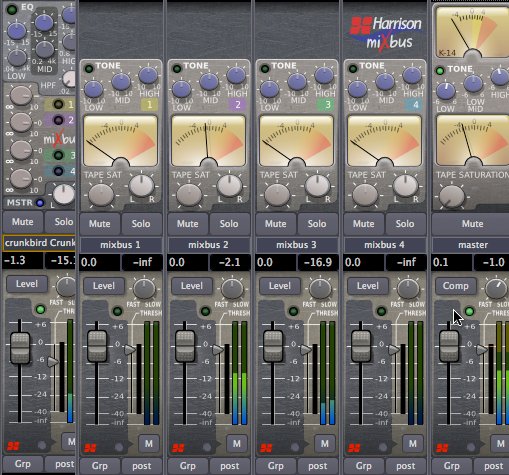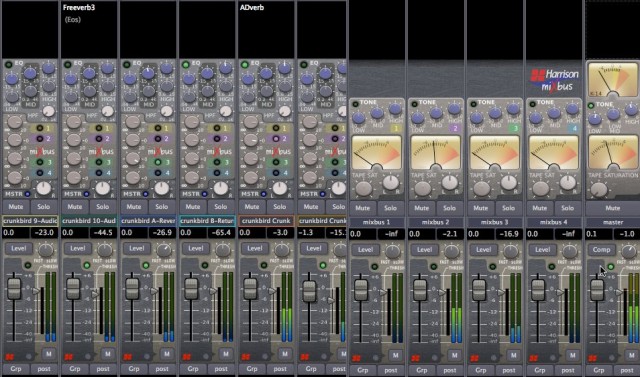Harrison is a company with a rich legacy in high-end consoles. Mixbus, their software product, is something of an anomaly. Its analog tape saturation, EQ, filter, compression, and mixing should be sold a la carte for a few hundred bucks each, given the usual business model in this industry. The product should run on some proprietary DAW, and should definitely come with a hardware dongle. And it absolutely, positively shouldn’t run on Linux, because everyone knows you can’t sell a product for Linux.
Instead, Mixbus sells for an intro price for US$79.99. You get the whole package: an entire DAW, plus a software version of Harrison’s 32-series and MR-series consoles, with powerful DSP and mixing features baked in. There’s no dongle. The DAW is the open source Ardour. On the Mac, you get support for Audio Unit plug-ins and any Core Audio interface, plus the superb Mac port of JACK.
And now, in addition to Mac support, you can run the package on Linux, benefiting from native Linux technologies like JACK and LADSPA and (now) LV2 plug-ins. Harrison recommends an audio-based distribution, but two of them – Ubuntu Studio and (Fedora-based) CCRMA – make their packages available in standard Ubuntu and custom Fedora repositories, respectively, which means just about any recent, major distribution will work.
Working with an open source DAW, Ardour, has some practical benefits for users. Aside from benefiting from a mature, open source codebase, the fact that Ardour is free software means you can exchange multitrack projects with friends, even if they don’t own Mixbus or do their work in a different DAW. Ardour takes some time to learn – the interface is spartan, to be sure – but because it’s a free project, it refreshingly focuses on the basics rather than the feature creep that has tended to make the major commercial, proprietary DAWs a bit complex.
Mixbus is simply a joy to use, because it consolidates the user interface into an efficient, productive console, and has some terrific effects to boost. Features:
- “Knob per function” mixing.
- EQ, filter, compression, analog tape saturation, and Harrison’s summing model
- 4 mix bus sends on every channel, and channel strips that each feature filter, EQ, and compression.
- Tone controls, compression, sidechaining, and tape saturation on the mix buses (hence the name), and on the stereo master bus, too – meaning this works nicely for mastering.
- Plugin delay compensation for features like parallel compression.
- Metering with peak, peak hold, compressor gain reduction on each track and bus – again, bringing mastering and mixing into a nice interface.
All of this operates in an extremely lightweight system that runs comfortably on a fairly low-end laptop, without having to sacrifice audio fidelity. (As with any multitrack system, just make sure you have a capable hard disk; that’s what I find to be the most significant bottleneck.)
In short, it’s a brilliant tool for plug-in hosting, thanks to all the routing options, and for finally finishing tracks, thanks to mix- and master-friendly features. On the Mac, support for AU means your plug-ins come with you from another DAW when you want to finish your music. On Linux (and on the Mac), you can use JACK to route in everything from a Pure Data patch to a recording for conventional mixing.
On the Mac, it’s a no-brainer purchase that makes a fantastic tool in your arsenal for finishing music. On Linux, it could be the release that finally makes a Linux-based studio practical.
Version 1.5 also introduces some new features alongside the Linux release, including a key-mappable “play with pre-roll” Transport command and playhead edit range Transport snapping (huge time-savers), thinning for dynamic automation, and a Gain tool you can use to adjust curves in a region.
I spoke to Harrison about some of the details of what’s on offer here.
CDM: Can you describe what’s built into Mixbus’ console from a processing standpoint? What makes this console special? A lot is made of “summing,” but that’s – unless I’m missing something you’re doing – typically the least interesting part of DSP design in a mixer. So tell us what does make working with Mixbus different sonically?
There’s the obvious stuff…. the built-in EQs, compressors, tape saturation, and final limiter…. done by our in-house DSP guys. But I assume that’s not what you mean.
One fundamental difference in Mixbus is the fact that everything is always “in” … for example, when you turn on an EQ, that processing is already allocated so you won’t push your CPU over the edge while undertaking the art of “mixing”. This sounds trivial, but it has significant implications in the workflow, sound, and “immediacy” of the mixer. A second big difference is the fixed number of pre-allocated buses (both graphically and DSP-wise) which is quite different from the normal DAW mixer. This will become more apparent as we develop Mixbus further, in a way that is parallel with – but different than – Ardour and more traditional DAWs.
Summing is a hot-button topic, for sure. On some level, there will be a simple addition, just like there is an addition of voltages/current on the summing bus of an analog console. But nobody would say that 2 analog consoles sound the same. Similarly, there are design decisions to be made on digital mixers. For example, our EQs are implemented in 64-bit, and there is a dither stage in each channel. When multiple channels are summed together, you can handle this dither in different ways. The difference isn’t in the actual summing, but qualitative differences come from these signals when they are summed.
Ed.: That makes some sense – the summing stage itself, which is what people will often describe when comparing DAWs, shouldn’t theoretically be any different, but the way you handle changes in bit depth in various mixing stages prior to summing could make a big difference. I pushed Harrison on this partly because I’ve been having some heated discussions with developers and engineers about this topic, so we can go further into it if interested – but it’s good to know how Mixbus works, and I can confirm that mixing in the software is really a joy. -PK
Finally, there’s the rule that in digital it’s hard to “improve” the quality of sound, but there are a hell of a lot of ways to screw it up. Avoiding these landmines, or designing to accomodate them on a given platform, is something that comes from a lot of experience.

What’s the relationship of Mixbus to other Harrison products? How did they inform this design?
We designed the Mixbus mixer using the same people & process that we would apply to a hardware mixer. Every design has “tradeoffs” associated with it: features, bit depth, gain stages, dithering, oversampling, parameter ramping methods, etc etc. There’s also a lot of thought that gets put into the parameter ranges …. where should the EQ center frequencies be? How wide a range should they cover? These are things that we (a) think about much more frequently than the typical DAW developer and (b) have a very wide experience to draw from.
Aside from the fact that it’s already there, can you talk about some specific advantages of working with Ardour? Any tips you’ve personally found while working with it, from a workflow / usability standpoint?
Coming from the rarified world of high-end audio systems, we recognized a lot of the same qualities in Ardour. Some examples: “The things you do 1000 times a day are very easy to apply, while the things you do once per day don’t matter where they appear” …. “Anything that you do automatically, while really helpful in some cases, will be terribly wrong in other cases” ….. “first-time-user intuitiveness isn’t as important as long-term usability to a pro” ….. “customization on a truly deep level is important for enterprise-class facilities” …. stuff like that.
These are subtleties. How do you make a soundbyte out of the overall “gestalt” that Ardour/Mixbus has? It is the result of many iterations driven by real-world users. Sometimes it’s about going back-and-forth until finally settling on the “least evil” of evil compromises. It doesn’t make good ad copy 🙂
One huge point: Ardour (in many cases) is a superset of the features of workstations. For example, the AudioFile (a high end hardware DAW by AMS/Neve) had the feature of “transparent regions”… so you could stack multiple sounds on a single track. Ardour has a “transparent” flag for regions, so you can do this. An interesting point here is that the Ardour session file format could conceivably become the shared standard of nearly other DAW. Presumably we’ll be able to support nearly any workflow that a user wants, once we get the UI’s developed.
Mixbus users – or potential Mixbus users – we’d love to hear from you. If you’re using the tool now, let us know how it’s working for you. And if you’re considering using it, let us know what’d be helpful to you. I suspect a tutorial on setting everything up on Linux would be a good place to start; it’s powerful, but not immediately intuitive out of the box.
http://www.harrisonconsoles.com/

